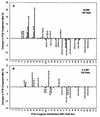Brominated Biphenyls Prime Extensive Microbial Reductive Dehalogenation of Aroclor 1260 in Housatonic River Sediment
- PMID: 9572952
- PMCID: PMC106231
- DOI: 10.1128/AEM.64.5.1786-1795.1998
Brominated Biphenyls Prime Extensive Microbial Reductive Dehalogenation of Aroclor 1260 in Housatonic River Sediment
Abstract
The upper Housatonic River and Woods Pond (Lenox, Mass.), a shallow impoundment on the river, are contaminated with polychlorinated biphenyls (PCBs), the residue of partially dechlorinated Aroclor 1260. Certain PCB congeners have the ability to activate or "prime" anaerobic microorganisms in Woods Pond sediment to reductively dehalogenate the Aroclor 1260 residue. We proposed that brominated biphenyls might have the same effect and tested the priming activities of 14 mono-, di-, and tribrominated biphenyls (350 µM) in anaerobic microcosms of sediment from Woods Pond. All of the brominated biphenyls were completely dehalogenated to biphenyl, and 13 of them primed PCB dechlorination. Measured in terms of chlorine removal and decrease in the proportion of hexa- through nonachlorobiphenyls, the microbial PCB dechlorination primed by several brominated biphenyls was nearly twice as effective as that primed by chlorinated biphenyls. Congeners containing a meta bromine primed Dechlorination Process N (flanked meta dechlorination), and congeners containing an unflanked para bromine primed Dechlorination Process P (flanked para dechlorination). Two ortho-substituted congeners, 2-bromobiphenyl and 2,6-dibromobiphenyl (2-BB and 26-BB), also primed Process N dechlorination. The most effective primers were 26-BB, 245-BB, 25-3-BB, and 25-4-BB. The microbial dechlorination primed by 26-BB converted ~75% of the hexa- through nonachlorobiphenyls to tri- and tetrachlorobiphenyls in 100 days and removed ~75% of the PCBs that are most persistent in humans. These results represent a major step toward identifying an effective method for accelerating PCB dechlorination in situ. The challenge now is to identify naturally occurring compounds that are safe and effective primers.
Figures





Similar articles
-
Complete reductive dehalogenation of brominated biphenyls by anaerobic microorganisms in sediment.Appl Environ Microbiol. 1998 Mar;64(3):940-7. doi: 10.1128/AEM.64.3.940-947.1998. Appl Environ Microbiol. 1998. PMID: 16349530 Free PMC article.
-
Temperature determines the pattern of anaerobic microbial dechlorination of Aroclor 1260 primed by 2,3,4,6-tetrachlorobiphenyl in Woods Pond sediment.Appl Environ Microbiol. 1997 Dec;63(12):4818-25. doi: 10.1128/aem.63.12.4818-4825.1997. Appl Environ Microbiol. 1997. PMID: 9406401 Free PMC article.
-
Two anaerobic polychlorinated biphenyl-dehalogenating enrichments that exhibit different para-dechlorination specificities.Appl Environ Microbiol. 1997 Dec;63(12):4826-32. doi: 10.1128/aem.63.12.4826-4832.1997. Appl Environ Microbiol. 1997. PMID: 9406402 Free PMC article.
-
A case study for microbial biodegradation: anaerobic bacterial reductive dechlorination of polychlorinated biphenyls-from sediment to defined medium.Annu Rev Microbiol. 2008;62:253-70. doi: 10.1146/annurev.micro.62.081307.162733. Annu Rev Microbiol. 2008. PMID: 18729735 Review.
-
Microbial reductive dechlorination of PCBs.Biodegradation. 1993-1994;4(4):231-40. doi: 10.1007/BF00695971. Biodegradation. 1993. PMID: 7764920 Review.
Cited by
-
Salinity determines performance, functional populations, and microbial ecology in consortia attenuating organohalide pollutants.ISME J. 2023 May;17(5):660-670. doi: 10.1038/s41396-023-01377-1. Epub 2023 Feb 10. ISME J. 2023. PMID: 36765150 Free PMC article.
-
In situ treatment of PCBs by anaerobic microbial dechlorination in aquatic sediment: are we there yet?Curr Opin Biotechnol. 2013 Jun;24(3):482-8. doi: 10.1016/j.copbio.2012.10.004. Epub 2012 Oct 23. Curr Opin Biotechnol. 2013. PMID: 23102490 Free PMC article. Review.
-
Enhanced reductive dechlorination of polychlorinated biphenyl impacted sediment by bioaugmentation with a dehalorespiring bacterium.Environ Sci Technol. 2011 Oct 15;45(20):8772-9. doi: 10.1021/es201553c. Epub 2011 Sep 25. Environ Sci Technol. 2011. PMID: 21902247 Free PMC article.
-
Advances and perspective in bioremediation of polychlorinated biphenyl-contaminated soils.Environ Sci Pollut Res Int. 2018 Jun;25(17):16355-16375. doi: 10.1007/s11356-017-8995-4. Epub 2017 May 9. Environ Sci Pollut Res Int. 2018. PMID: 28488147 Free PMC article.
-
The Dehalococcoides population in sediment-free mixed cultures metabolically dechlorinates the commercial polychlorinated biphenyl mixture aroclor 1260.Appl Environ Microbiol. 2007 Apr;73(8):2513-21. doi: 10.1128/AEM.02909-06. Epub 2007 Feb 16. Appl Environ Microbiol. 2007. PMID: 17308182 Free PMC article.
References
-
- Bedard D L, Bunnell S C, Smullen L A. Stimulation of microbial para-dechlorination of polychlorinated biphenyls that have persisted in Housatonic River sediment for decades. Environ Sci Technol. 1996;30:687–694.
-
- Bedard D L, May R J. Characterization of the polychlorinated biphenyls in the sediments of Woods Pond: evidence for microbial dechlorination of Aroclor 1260 in situ. Environ Sci Technol. 1996;30:237–245.
-
- Bedard D L, Quensen J F., III . Microbial reductive dechlorination of polychlorinated biphenyls. In: Young L Y, Cerniglia C E, editors. Microbial transformation and degradation of toxic organic chemicals. New York, N.Y: Wiley-Liss Div., John Wiley & Sons, Inc.; 1995. pp. 127–216.
-
- Bedard D L, Smullen L A, May R J. Abstracts of the 1996 International Symposium on Subsurface Microbiology. Zürich, Switzerland: Swiss Society of Microbiology and Institute of Plant Biology, University of Zürich; 1996. Microbial dechlorination of highly chlorinated PCBs in the Housatonic River, abstr. 81; p. 117.
-
- Bedard D L, Van Dort H M. The role of microbial PCB dechlorination in natural restoration and bioremediation. In: Sayler G S, Sanseverino J, Davis K, editors. Biotechnology in the sustainable environment. New York, N.Y: Plenum Publishing Corp.; 1997. pp. 65–71.
LinkOut - more resources
Full Text Sources
Other Literature Sources

